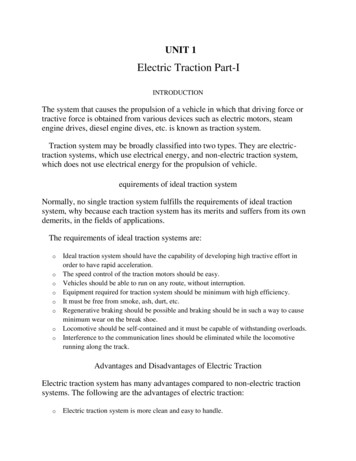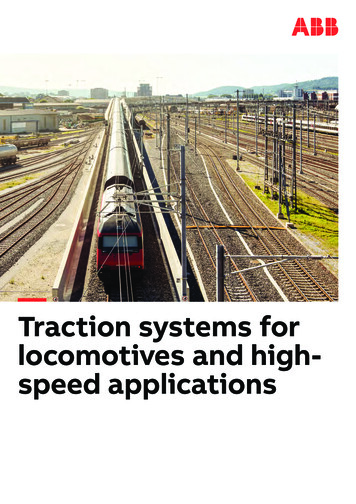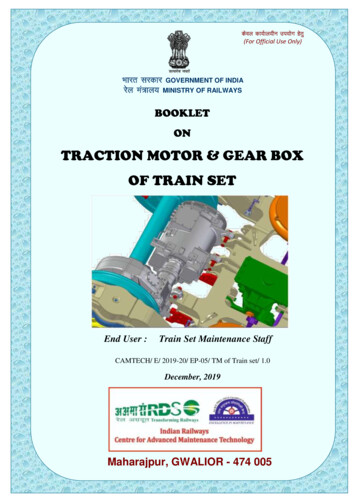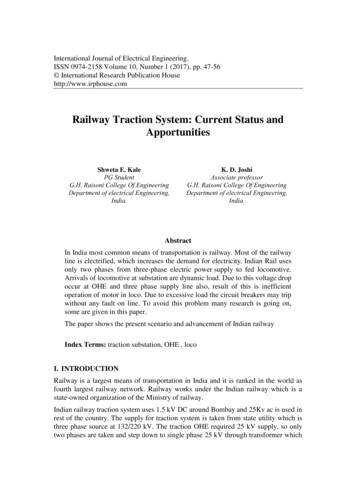
Transcription
Founded in 2015, Wildcat Venture Partners invests inearly-stage technology companies. The Wildcat teambrings decades of entrepreneurial experience, venture experience, and deep domain expertise to helpstartups effectively navigate through the Traction Gap.“Traction. That was the word that haunted their fund-raising lives.elusive? How do you get it? HowTraction Gap Framework helps management teams and their—GEOFFREY MOORE, AUTHOR OF“The Lean Launchpad class was developedproduct that customers want. The Traction Gap isstep in that progression, taking a minimally viable productability and traction.”“This iscore businessto a solid, growing company—people, product,givesversing the Traction Gap“All early-stage startups are faced with themake it, they need aSuccessful startups are rare.ups fail. Most startups canstumble when it comesthe Traction Gapwww.radiusbookgroup.comTR AC TION. STARTUPS NE E D IT. LEARN HOW TO GET IT.TRAVERSINGTHETRACTIONTRAVERSING THE TRACTION GAPABOUT WILDCAT VENTURE PARTNERSPRAISE FOR TRAVERSING THE TRACTION GAPBRUCE CLEVELAND &WILDCAT VENTURE PARTNERSBRUCE CLEVELAND,Founding Partner of Wildcat Venture Partners, focuseson investments in emergingtechnologies—artificial-intelligence (AI) marketing, EdTech,SaaS, and IoT startups.He was the first investor anda board member of Marketo,which held an IPO in 2013 andwas acquired in 2018 by Adobe for 4.75B. He wasalso an early-stage investor in other notable companiessuch as C3, Doximity, Vlocity, and Workday. Bruce heldsenior executive roles in engineering, product management, and product marketing at Apple, AT&T, Oracle,and Siebel Systems.Creating new companies and navigating new markets are his most enjoyable challenges. He is committed to sharing his knowledge and experience throughthe Traction Gap Framework , which helps entrepreneurs navigate the critical go-to-market period.He attended the US Military Academy, West Point,New York, and received a BS in business administration from CSU, Sacramento. He lives in the San Francisco Bay area, near Wildcat Venture Partners’ SanMateo, California, headquarters.GAP BRUCE CLE VE L AN DFOREWORD BY GEOFFREY MOORE, BESTSELLING AUTHOR OF CROSSING THE CHASM& VENTURE PARTNER AT WILDCAT VENTURE PARTNERS
Distributed by Radius Book GroupA Division of Diversion Publishing Corp.443 Park Avenue South, Suite 1004New York, NY 10016www.RadiusBookGroup.comCopyright 2019 by Bruce Cleveland and Wildcat Venture PartnersAll rights reserved, including the right to reproduce this book or portions thereof in any formwhatsoever. No part of this publication may be reproduced or transmitted in any form or byany means, electronic or mechanical, including photocopying, recording, or any other information storage and retrieval, without the written permission of the author.For more information, email info@radiusbookgroup.com.Library of Congress Control Number: 2018958128First edition: February 2019Hardcover ISBN: 978-1-63576-573-1Trade Paperback ISBN: 978-1-63576-624-0eBook ISBN: 978-1-63576-574-8Manufactured in the United States of America10 9 8 7 6 5 4 3 2 1Cover design by Mark KarisInterior design by Pauline Neuwirth, Neuwirth & AssociatesRadius Book Group and the Radius Book Group colophon are registered trademarks of Radius Book Group, a Division of Diversion Publishing Corp.8238 Traversing FIN.indd 412/13/18 1:23 PM
INTRODUCTIONThis is an unusual business book.Unusual because unlike many business books, we have set out to provide you with a set of prescriptive techniques and tactics you can leveragewith your own startup—or with your portfolio companies if you are a ventureinvestor. We are venture capitalists and entrepreneurs, not academics; ourorientation is toward real-life business success, not interesting theories. Wewill always choose messy successes over elegant failures.This book contains valuable lessons that my Wildcat partners and I havelearned in our careers, combined with tried, tested, and proven techniquesused by teams to successfully traverse one of the most challenging phases ina startup’s life cycle: we call it the “Traction Gap.” As you will see, this journeyis almost never smooth. That’s why this is a guide, not a bible. Every entrepreneur’s experience will be different.Why should you value the advice in this book? Well, I, along with the members of the Wildcat Venture Partners team who have contributed to its contents, have been involved with successful Silicon Valley companies and thetechnology industry in some manner for at least twenty years.38238 Traversing FIN.indd 312/13/18 1:23 PM
TR A V E R S IN G TH E TR A C T I ON GA PI have held operating roles in several Silicon Valley technology companiesthat were small startups at the time I joined them. At Oracle, I began as a midlevel manager when it was a private company of 100 employees located onSand Hill Road in Menlo Park. At 27, I was given the opportunity to build a division, and in less than four years we grew from a “startup” inside Oracle to amajor contributor to Oracle’s top line. After Oracle, I joined Apple and ran itsUnix and object technology divisions. In 1996, I joined Siebel Systems as amember of its senior executive team just after it completed a 2M year; fiveyears later, we generated 1.7B in revenue. All three companies are among themost transformational technology companies in Silicon Valley history.After we sold Siebel to Oracle in 2006, I elected to try my hand at investingin startups as a member of a venture firm. One of my first investments was inMarketo, when it was essentially just an idea with three talented people. Thissmall team was led by Phil Fernandez, who went on to transform the marketing function as we know it. With C3, I was invited by Tom Siebel to participate in helping the company form its original business plan and thensubsequently invest in it; and when Doximity’s founder, Jeff Tangney, sat inthe offices of my former venture firm as an Executive in Residence, I had theprivilege of watching him work his way through the process of selecting oneamong three ideas he was contemplating and go on to create a market-leadingapplication for physicians and the healthcare industry.My Wildcat partners have each had similar experiences, helping to eitherbuild or advise startups to go on to become successful market-leading companies.As such, we have had a front-row seat where we have learned what is required to take an idea from startup to category leader. These invaluable experiences, working with incredible people, serve as the foundation for theprinciples developed and documented as part of the Traction Gap Framework.What compelled me—and my Wildcat partners to encourage me—to writethis book? It was a troubling statistic. More than 80 percent of all startups fail,48238 Traversing FIN.indd 412/13/18 1:23 PM
Introductionaccording to Dow Jones VentureSource, Correlation Ventures, CB Insights,and other sources. And the percentage may be even greater than that.I am talking about thousands of failed companies every year. Many entrepreneurs believed they had valuable, important new products . . . and yet theyfailed, in spite of their belief and their best all-out efforts.These companies either failed outright or failed to return at least the capital invested. This is a tremendous waste: lost capital, lost jobs, and lostdreams. Some of the smartest people in our economy invest significantamounts of time, effort, and capital that ultimately produce no tangible result.And here’s the worst of it.Most startups can engineer a product; but, sadly, the vast majority stumblewhen it comes to engineering a market for that product. Just as important as theproduct itself is accurately assessing and validating market need for that product, then defining or redefining that market, so that their beautifully engineeredproduct has a chance to succeed. To do any less is a colossal wasted effort.As early-stage investors, we wanted to expose the reasons behind that 80percent failure rate, especially when venture firms widely proclaim their ability to “add value” as a core competency.What we have discovered—what I will discuss in depth in the pages thatfollow—is that every startup must pass through three distinct phases:1. Go-to-Product,2. Go-to-Market, and3. Go-to-Scale.For negotiating the go-to-product phase, founders have a tremendousamount of information and support for their startup. Incubators, accelerators,angel investors—all are ready and eager to help. For example, Steve Blank’sexcellent book, The Startup Owner’s Manual, is a phenomenal reference forany startup team seeking to navigate the go-to-product phase.That said, I have elected to devote a significant portion of this book—thefirst four chapters—to exploring some critical issues in the go-to-product period. The issues I discuss have not been dealt with as readily, yet are mission- 58238 Traversing FIN.indd 512/13/18 1:23 PM
TR A V E R S IN G TH E TR A C T I ON GA Pcritical; and if you do not address these issues satisfactorily, they will at aminimum compromise your success or, worse, lead to an early shutdown.I will introduce you to terms, concepts, and strategies that will enable youto navigate and exit the go-to-product phase, prepared to take on and successfully traverse the Traction Gap, the meat of this book, what I later term “Slide29.” You’ll read a lot about Slide 29 in Chapter 1 and throughout this book.For those relatively few startups that actually make it to the third—go-toscale—phase, a significant amount of information and support exists for themas well. Consultants and books abound with information that can help founders “cross that chasm” (to paraphrase Geoffrey Moore’s title of his best-sellingbook) and begin to scale. We are privileged to have Geoff, the master of marketing challenges, as one of our partners here at Wildcat Venture Partners,and I know he agrees with what I am about to tell you:While there is a substantial amount of information and support for the firstand third phases, there is very little data or support for teams making theirway through the second—go-to-market—phase.Very few business metrics exist at this point in a startup’s life cycle. So spreadsheet analysis offers little help to the management team as it attempts to develop a category, define it, and create sophisticated demand-generation andrevenue-conversion programs.This lack of internal and external support could not come at a worse time.Startups in the go-to-market stage face tremendous financial risk. They havea limited amount of time to figure things out and get them right. In manyways, they are never more vulnerable.It is this dangerous and tumultuous period that we have labeled the “Traction Gap” and presented as the main topic of this book. Fail to generate sufficient traction during this phase, and your startup will never get the opportunityto cross the chasm to its next era of growth. More likely instead, it will cometo a sad and dismal end. However optimistic your beginnings, you will end upon the scrap heap of the 80 percent.68238 Traversing FIN.indd 612/13/18 1:23 PM
IntroductionI wrote this book, with my Wildcat partners’ significant input and support,to help you keep that from happening.Soon after documenting and formalizing the Traction Gap Framework anddetermining a set of best practices, the Wildcat team shared the findings withportfolio companies and startups to get their feedback.The response was overwhelmingly positive. Many entrepreneurs asked usif we would write a book about the Traction Gap—and how to successfullytraverse it. I volunteered to take on the challenge. After considerable effort,significant and wonderful contributions from my Wildcat partners and others, and a lot of field testing, here it is.Our approach is not just to characterize the Traction Gap, but to show howunderstanding it will profoundly impact your product introductions as wellas your product creation, marketing, sales, and support—and your financing.In fact, if there’s one important discovery we’ve made in our research intothe Traction Gap, it is that most entrepreneurs don’t really understand thatthey need to engineer two products: one that they sell to businesses or consumers, and the other a financial product—their company—that they mustsell to investors. In Chapter 2, “Applying the Traction Gap Framework,” I talkabout developing a capitalization strategy. To secure capital, you typicallymust recruit outside investors. You must be able to persuade those investorsto commit to your idea and startup; you aren’t selling investors a consumer orbusiness product or service, you are selling them a financial product. Consequently, your approach and content with investors must be different.One of the common mistakes I have seen inexperienced entrepreneursmake is to simply take the product deck they might use with a potential customer, add a financials and a team slide, and use that to try to raise capital.The lack of understanding how to market and sell to investors, coupledwith how much and when to capitalize a startup, are key contributing factorsto the failure of many startups.I will explain all this in detail in the pages that follow. I know I speak for78238 Traversing FIN.indd 712/13/18 1:23 PM
TR A V E R S IN G TH E TR A C T I ON GA Pmy partners when I say that if we can save one promising startup—or get oneof our professional venture peers to reconsider their investment evaluationmodel—we will consider this book a success.Every venture firm, entrepreneur, angel investor, and limited partner tendsto refer to a startup based upon its latest financing round—Series Seed, A, B,C, . . . and so on—and we are forced to use those terms as well because theyare the accepted industry vernacular. But financing rounds are actually a terrible proxy for a startup’s maturity. In fact, they provide little insight into thetrue progress of these formative companies. I hope to convince you that byusing Traction Gap Framework’s terminology, labels, and metrics, we will allhave far better clarity into a startup’s actual maturity.The following is a representative sample of startups that the members ofthe Wildcat team have invested in and the name of the financing round whenone of us first invested.Traction Gap Frameworkwith Company Financing RoundsFIGURE 1Notice that there is little correlation between the name of the round andthe maturity of the startup. My Wildcat partner, Bill Ericson, and I investedin a database company that didn’t reach MVP until after its fourth round offinancing. Why? Because it takes a lot of capital to produce a commercialdatabase. We are experienced investors in this area—databases and infrastruc-88238 Traversing FIN.indd 812/13/18 1:23 PM
Introductionture—and the fact that it took this much capital to reach MVP did not comeas a surprise to us. In fact, we allocated significant follow-on capital from ourinitial investment to support the company for this very reason. A mobile consumer app might take only one or two rounds of capital before it’s off to theraces and scaling.The simple truth is that financing rounds don’t tell anyone much of anything other than that the startup successfully raised capital, which is mostassuredly not a barometer of future success.When venture firms provide an annual accounting and assessment oftheir early-stage portfolio to their limited partners (LPs—the investors inventure capital firms), we believe that adopting and using Traction Gapvalue inflection points, metrics, and nomenclature is a far better way toconvey the true progress of those startups, rather than referring to theirfunding rounds. At Wildcat, we use the Traction Gap Framework vernacularwith all portfolio company interactions, when we make investment and reinvestment decisions, and when we report the progress of our portfoliostartups to our LPs.If we can provoke a widespread revamping of the entrepreneurial startupinvestment model, we believe we can have a measurable, positive impact onthe world economy.We will admit up front to a narrative bias toward entrepreneurial startupsover large, mature companies, and high technology—specifically software—over other industries. The reason for the first is that while the Traction Gapcan appear in any company at any time in its history, it is most pronouncedin—and is the greatest threat to—small, new startups, where failure to navigate that gap can represent an existential threat.This book is also primarily focused on B2B software startups using a subscription model: well, that’s the business we are in at Wildcat. However, webelieve that the issues associated with the Traction Gap are a universal phenomenon—and that while my examples largely come from Silicon Valley98238 Traversing FIN.indd 912/13/18 1:23 PM
TR A V E R S IN G TH E TR A C T I ON GA PB2B—and some B2C—software companies, many of these concepts can beapplied anywhere and everywhere.One final note here: you will see that I mention and feature many companies throughout this book. Specifically, I spend some time on GreenFig andObo. These are two companies that I personally founded; I’m not just an investor. I share information about them with you as a kindred-spirit entrepreneur, not with the intention of promoting them over other products andservices.I also discuss other companies and products by name. I did this becausethese are companies with which I have some familiarity. Neither I nor Wildcathas received any compensation to mention them in this book. And, in almostall cases, they participate in markets with many competitors. If and when youconsider using a particular product for a specific purpose that I may highlightin this book, I encourage you to actively engage and review alternative offerings and not just the companies and products I happen to call out.I hope you enjoy this book and the business anecdotes from successfulentrepreneurs very much like you, who were faced with similar issues. Moreimportantly, I hope the book serves as an important reference manual foryour own journey across the Traction Gap—or, alternatively, if you are a venture investor, for how you and your firm make investment and reinvestmentdecisions. When your startup or your portfolio companies survive and successfully reach the other side, please drop us a note and tell us your own uplifting story.Bruce Cleveland & the Wildcat Venture Partners TeamSan Mateo, California108238 Traversing FIN.indd 1012/13/18 1:23 PM
“This is the exact book I would use to teach a class on scaling a company. It focuses on thecore business areas entrepreneurs need to professionalize as they go from a pure startupto a solid, growing company—people, product, revenue, and systems. More than that, itgives them milestone metrics based on successful companies to help them gauge theirprogress and communicate better with investors.”—WAVERLY DEUTSCH, CLINICAL PROFESSOR AND ACADEMIC DIRECTOR OFUNIVERSITY-WIDE ENTREPRENEURSHIP CONTENT AT UNIVERSITY OF CHICAGOBOOTH SCHOOL OF BUSINESS“Bruce is one of the leading experts on scaling startups, especially in the enterprise.Traversing the Traction Gap packages up years of lessons and contains exactly the typeof information and guidance that would have accelerated our growth early on!”—AARON LEVIE, CEO AND FOUNDER, BOXSuccessful startups are rare. More than 80 percent of all early-stage startups fail. Most startups can build a product, but, sadly, the vast majoritystumble when it comes time to take those products to market. Traversingthe Traction Gap exposes the reasons behind that scary failure rate andprovides a prescriptive how-to guide for startups to succeed.B R U C E C L E V E L A N D , Founding Partner at Wildcat VenturePartners, focuses on investments in early-stage AI marketing, EdTech,SaaS, and IoT startups. Bruce enjoys the challenge of creating newcompanies and navigating new markets. He is committed to sharinghis knowledge and experience through the Traction Gap Framework ,which helps entrepreneurs navigate the critical go-to-market period.Radius Book Group 2/21/2019BUSINESS & ECONOMICS—EntrepreneurshipHardcover 35.99 978-1-63576-573-1Trade Paperback 18.95 978-1-63576-624-0288p 6” x 9”ISBN 978-1-63576-573-1www.radiusbookgroup.com9 781635 76573153599
Traction Gap Framework helps management teams and their —GEOFFREY MOORE, AUTHOR OF "The Lean Launchpad class was developed product that customers want. The Traction Gap is step in that progression, taking a minimally viable product ability and traction." "This is core business to a solid, growing company—people, product, gives










